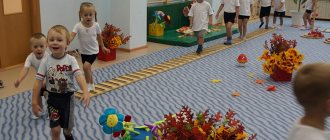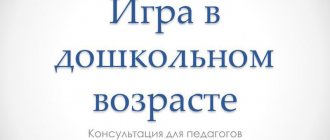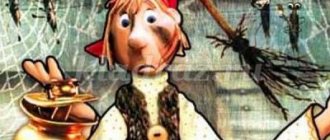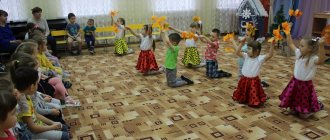Theatrical activity is the most important factor in the development of a preschooler’s personality
One of the most popular and exciting areas in preschool education is theatrical activities. From the point of view of pedagogical attractiveness, we can talk about the versatility, playful nature and social orientation of the theater. Of all types of games, theatrical play has a special impact on the development of the ability to recognize a person’s emotional state by facial expressions, gestures, intonation, the ability to put oneself in the place of another in various situations and find adequate ways to assist. Theatrical activity is an inexhaustible source of development of feelings, experiences and emotional discoveries, a way of becoming familiar with spiritual wealth. As a result, the child learns about the world with his mind and heart, expressing his attitude towards good and evil; learns the joy associated with overcoming communication difficulties and self-doubt.
In pedagogical research, theatrical activities are considered as a condition for the aesthetic education of a child, his artistic abilities, and creativity. An analysis of the literature made it possible to highlight the peculiarities of the perception of theatrical action by preschool children, open contact and exchange of feelings with the characters, the need for individual self-expression, and the child’s desire to reproduce the favorite character. The main problem is related to the development of scripts for children's theaters in a preschool institution and the development of image creation skills. The humanistic idea of education draws the attention of teachers and practitioners to the development of personal values, to the child’s self-expression of his image and type of behavior in the space of peers and adults. Theatrical activity is the optimal condition for solving problems related to the development in a child of the values of compassion, mercy, philanthropy and the ways of their manifestation, thereby forming the experience of life, creating a holistic picture of the world.
It is theatrical activities that make it possible to solve many pedagogical problems relating to a holistic picture of the world, including the formation of the expressiveness of a child’s speech, intellectual and artistic-aesthetic education. When participating in theatrical games, children form ideas about events in the lives of people, animals, and plants, which gives them the opportunity to gain a deeper understanding of the world around them. At the same time, theatrical play instills in the child a sustainable interest in his native culture, literature, and theater. The educational value of theatrical games is also enormous. Children develop a respectful attitude towards each other. They learn the joy associated with overcoming communication difficulties and self-doubt. Thus, from the above we can conclude about the importance of theatrical art in the development of the personality of a preschool child; it allows solving problems related to intellectual, artistic, aesthetic, moral education, and socialization of the individual.
The types and content of theater classes include: 1) general developmental games that develop attention, observation, courage, resourcefulness, and readiness for creativity; 2) rhythmoplastic exercises, which involve the development of motor ability and plastic improvisation; 3) psycho-gymnastic studies aimed at the formation of the cognitive and social-personal sphere; 4) special theatrical games that prepare children for action in stage conditions, where everything is fiction, develop imagination and fantasy; 5) tasks on the culture and technique of speech, improving breathing, diction, intonation and other means of expressive speech; 6) conversations and quizzes about theatrical art; 6) sketches and games for controlling theatrical puppets, developing hand muscles, endurance, and patience.
Through the means of the art of theater, it promotes familiarization with its expressive language, which lays the foundation for the formation of skills of perception, understanding and interpretation of actions that form the moral foundations, ideas, and actions of a person; developing skills of mutual communication and teamwork. In accordance with this approach, the program ensures the development of the personality, motivation and abilities of children in various types of activities in the following areas of development: social-communicative, cognitive, speech, artistic-aesthetic and physical.
At the same time, it is necessary to highlight a number of contradictions that exist in the practice of work of a preschool educational institution in connection with the formation of a holistic picture of the world in children of senior preschool age:
– between teachers’ understanding of the need to solve the actual problem of the developed content of a holistic picture of the world and the lack of systematic and consistent work, which is often situational and pedagogically inappropriate;
– between the use by teachers of traditional types of theatrical activities in the formation of a holistic picture of the world among pupils and ineffective organization, which does not take into account the modern characteristics and interests of older preschoolers, their desire for independence and initiative, children's activity, its satisfaction in theatrical games, as well as developmental potential and the possibilities of the theatrical activity itself;
– between the growing interest of modern preschoolers in integrative activities, in particular, theatrical activities, and its non-systematic use in the pedagogical process, the unpreparedness of teachers and parents for its implementation.
The indicated contradictions and the need to resolve them determine the relevance of the scientific problem, the search for new pedagogical solutions in the aspect of forming a holistic picture of the world of older preschoolers in theatrical activities.
Domestic teachers and psychologists consider theatrical activity as a specific type of artistic and creative activity that is of great importance for the versatile development of preschool children (L. V. Artyomova, L. S. Vygotsky, N. S. Karpinskaya, D. B. Mendzheritskaya, B. M. Teplov, L. G. Strelkova). L. S. Vygotsky defined theatrical activity as the most common type of children's creativity, since the dramatic form of reflecting life impressions is organically inherent in children's nature and finds its expression spontaneously, regardless of the wishes of adults. It includes various symbolic-modeling activities and is built on the organic unity of play, speech, drawing (M. A. Vasilyeva, L. A. Wenger, O. M. Dyachenko, A. A. Leontyev, S. I. Merzlyakova, L. G. Milanovich, N. F. Sorokina, E. L. Trusova).
The specificity of theatrical activity is that it allows you to implement the principles of natural conformity and cultural conformity of education (M. I. Nikitina) through the formation of an “image of the world” (A. N. Leontiev), the development of spatio-temporal orientation, familiarity with the laws of nature - cyclicity, interrelation and interdependence of objects and phenomena of the surrounding reality. At the same time, in the process of theatrical activity, the ability to distinguish the world of ideas, imagination from reality, the real world is formed (L. A. Wenger, O. M. Dyachenko, E. E. Kravtsova, S. N. Nikolaeva, etc.).
In the process of theatrical activities, various communication situations are modeled, coherent speech develops, which is a necessary condition for the child’s adaptation in society (M. A. Vasilyeva, O. L. Knyazeva, R. B. Sterkina, S. A. Kozlova, etc.). Children develop volition, special sensitivity and attention to the actions of people in life, the ability to see and understand the meaning of the simplest human actions, his feelings, relationships with people, nature (A.B. Zaporozhets, L.G. Strelkova, E.L. Trusova, D. B. Elkonin and others). In addition, research emphasizes the universal nature of theatrical activities, since they contribute to the formation of various sign systems, the development of cognitive, motor and emotional spheres, as well as the socialization of children (S. I. Merzlyakova, L. G. Milanovich, N. F. Sorokina and etc.).
In preschool pedagogy, the work of scientists O. V. Akulova, L. V. Artemova, T. N. Karamanenko, S. G. Mashevskaya, T. G. Pen, A. A. Petrova, E. R. was devoted to the problem of theatrical activities. Ragul, B.P. Yusova, etc. Analysis of the works of these authors made it possible to determine the directions that have developed in the study of this issue. L.V. Artemova suggests using theatrical games as a strong pedagogical tool that has a great influence on the child’s personality. S. G. Mashevskaya considers the structure of theatrical activity, which includes three links - writing, performance and perception. This makes it possible to make wider use of children’s creative capabilities, determining their “acting”, “directing” and “spectating” potential. A. A. Petrova highlights two aspects of the closeness of the dramatic form for the child, firstly, the dramatic form of “living out the impressions of life” lies deep in the nature of the child and finds its expression spontaneously. Children's fantasies and images do not remain in the realm of dreams, as with adults. The child wants to translate all his imagination and impressions into living images and actions. Secondly, there is a connection between any dramatization and play. B.P. Yusov sees the development of a child through the means of theater, that is, the child becomes involved in productive creative activity.
Literature:
- Vygotsky L. S. Game and its role in the psychological development of a child / L. S. Vygotsky // Developmental Psychology. - St. Petersburg, 2001. - pp. 56–79.
- Doronova T. N. We play in the theater. Theatrical activities of children / T. N. Doronova. - M.: Education, 2004. - 127 p.
- Komarova T. S. Development of artistic abilities of preschoolers / T. S. Komarova. - M.: Mozaika-Sintez, 2013. - 160 p.
- Komarova T. S. School of aesthetic education / T. S. Komarova. - M.: Kingfisher, 2006. - 416 p.
Theatrical and gaming activities in senior preschool age
Table of contents
Introduction 3
Chapter 1 Psychological and pedagogical foundations of theatrical and gaming activities
1.1 The concept of gaming activity 6
1.2 History of the game 11
1.3 Types and classifications of games 15
1.4 Theatrical and play activities of preschoolers 21
Chapter 2 Organization of theatrical and play activities for children of senior preschool age in a preschool educational institution
2.1 Taking into account the age characteristics of children of senior preschool age when organizing theatrical and play activities in the conditions of preschool educational institution 31
2.2 The role and significance of theatrical and play activities for children of senior preschool age in preschool educational institutions 36
2.3 Methodological recommendations for organizing theatrical and play activities for children of senior preschool age in preschool educational institutions 40
Conclusion 50
References 53
Introduction
In modern society, the social prestige of intelligence and scientific knowledge has sharply increased. Associated with this is the desire to give knowledge, teach them to read, write and count, and not the ability to feel, think and create. A pedagogical focus primarily on the development of thinking turns the child’s emotional and spiritual essence into a secondary value. Modern children know much more than their peers 10-15 years ago, they solve logical problems faster, but they are much less likely to admire and be surprised, be indignant and empathize, more and more often they show indifference and callousness, their interests are limited, and their games are monotonous. In addition, recently many preschoolers do not attend kindergartens, and Barbie dolls, computers, and television are not able to compensate for the lack of a children’s community, without which the full mental and social development of a child’s personality is impossible.
The relevance of the work is that, noting the lack of observation and creativity in some first-graders, psychologists often make the diagnosis: “underplayed,” i.e. have not trained their fantasy and imagination in the unpredictable and joyful process of “creating a game”; in preschool age, as a rule, such children do not know how to occupy themselves in their free time and look at the world around them without surprise and special interest, as consumers, and not as creators .
There is another important problem that worries teachers and psychologists. According to research, during the period of a child’s psychological adaptation to school, 67-69% of first-graders experience fears, breakdowns, and lethargy, while others, on the contrary, experience swagger and fussiness. Children often lack voluntary behavior skills and have underdeveloped memory and attention. The shortest way to emotionally liberate a child, relieve tension, teach feeling and artistic imagination is the path through play, fantasy, and writing. Theatrical activities can provide all this. Being the most common type of children's creativity, it is dramatization, “based on an action performed by the child himself, that most closely, effectively and directly connects artistic creativity with personal experiences” (L.S. Vygotsky).
Since ancient times, various forms of theatrical performance have served as the most visual and emotional way of transmitting knowledge and experience in human society.
Later, theater as an art form became not only a means of learning about life, but also a school of moral and aesthetic education for younger generations. Overcoming space and time, combining the capabilities of several types of arts - music, painting, dance, literature and acting, theater has a tremendous power of influence on the emotional world of a child. Performing arts classes not only introduce children to the world of beauty, but also develop the sphere of feelings, awaken complicity, compassion, and develop the ability to put oneself in the place of another, to rejoice and worry with him.
The purpose of the course work: to identify pedagogical conditions for the organization and conduct of theatrical and play activities for children of senior preschool age in a preschool educational institution
Object of study: theatrical and play activities
Subject of research: theatrical and play activities of children of senior preschool age in preschool educational institutions
Based on the object and subject of research, the following tasks can be formulated:
1. Consider the essence of gaming activity;
2. Study the history of the game;
3. Consider the types and classification of games;
3. Consider the features of theatrical and play activities of preschool children;
5. Identify the age characteristics of children of senior preschool age;
6. Identify the role and significance of theatrical and play activities for children of senior preschool age in preschool settings;
7. Develop methodological recommendations for organizing and conducting theatrical and play activities for children of senior preschool age in preschool educational institutions
Research methods:
— analysis of psychological and pedagogical literature on the research topic;
- observation
Structure of the work: This course work consists of an introduction, two chapters, a conclusion, and a list of references.
Chapter 1 Psychological and pedagogical foundations of theatrical and gaming activities
1.1 The concept of gaming activity
Play occupies a very important, if not central, place in the life of a preschooler, being the predominant type of activity. In Russian psychology and pedagogy, play is considered as an activity that is very important for the development of a preschool child; it develops actions in ideas, orientation between people, initial skills of cooperation (A.V. Zaporozhets, A.N. Leontyev, D.B. Elkonin, etc.).
A game is a form of activity in conditional situations aimed at recreating and assimilating social experience fixed in fixed ways of carrying out objective activity.
One of the provisions of the pedagogical theory of play is the recognition of play as a form of organizing the life and activities of preschool children. The first attempt to organize the lives of children in the form of games belonged to F. Frebel. In domestic pedagogy, the idea that the life of a kindergarten should be filled with a variety of games was developed by N.K. Krupskaya. Noting the importance of games for preschool children, N.K. Krupskaya wrote: “...game for them is study, game for them is work, game for them is a serious form of education.” Game for preschoolers is a way of learning about the environment. According to N.K. Krupskaya, the task of the teacher is to help children organize games, to unite them in the game. [9:252]
The idea of the need to “permeate the whole life” of a small child with play was expressed by Makarenko. Highly appreciating the play of children, A.S. Makarenko wrote: “Play is important in a child’s life, it has the same meaning as activity, work, service for adults. What a child is like at play, so in many ways he will be at work when he grows up. Therefore, the education of a future leader occurs primarily in play. [12:123]
K. D Ushinsky is considered the founder of game theory in Russian science. He contrasts the preaching of the spontaneity of play activity with the idea of using play in the general system of education, in preparing the child through play for work. Play, according to Ushinsky, is a unique kind of activity, moreover, a free and necessarily conscious activity, by which he understood the desire to live, feel, and act. “We must not forget,” writes K.D. Ushinsky, “that the game in which the child’s soul works independently is also an activity for the child.” Ushinsky was one of the first to argue that the game combines desire, feeling and imagination at the same time.[18:290]
Depriving a child of play as a conscious activity is the most terrible punishment for him.
I. And Komensky viewed play as a child’s natural need to move and play, because every healthy child simply needs to move. “The more a child does, runs, works, the better he then sleeps, the better he absorbs food, the better he grows, the better the health and freshness of his body and mind he acquires: but you must always take care of him so that there are no injuries”[10: 194]
Games, according to J. A. Komensky, strengthen the child’s health, educate his senses, improve movement, dexterity, spiritual freshness and vigilance.
“It is better to play than to sit idle, because in a game the mind is always busy with something and is often polished.” [10:201]
Comenius also understood play as a natural education of the will, character traits and entire personality of a child.
S. L. Rubinstein was the first to attempt to create a domestic theory of the game. According to Rubinstein, the essence of play lies in the fact that it is a product of practice through which reality is transformed and the world changes: “In play, the child’s need to influence the world is formed and manifested.” For this reason alone, it is a meaningful activity. The idea that play is a meaningful activity was developed in his works by A. N. Leontyev. “The specific difference between the play of a preschooler,” writes Leontiev, “from the play of animals is characterized by the fact that it is not instinctive, but precisely objective activity, which, forming the basis of the child’s consciousness of the world and human objects, determines the content of the child’s play”[16: 380]
P.P. Blonsky believes that game is a general name for a wide variety of child activities. Blonsky probably takes this statement to the extreme. He is inclined to think that “game in general” does not exist, there is no type of activity that would fit this concept, because the very concept of play is an adult concept, but for a child it is still serious. And this concept must be expelled from psychology. Blonsky describes the following episode. When it was necessary to instruct one of the psychologists to write an article “Game” for the encyclopedia, he declared that “game” is a word behind which nothing is hidden and which should be expelled from psychology.
The game always appears as if in two time dimensions: in the present and the future. On the one hand, it provides the individual with momentary joy and serves to satisfy current needs. On the other hand, the game is aimed at the future, since it either predicts or simulates life situations, or reinforces the properties, qualities, skills, and abilities necessary for an individual to perform social, professional, and creative functions. V.L. Sukhomlinsky wrote: “Let us take a closer look at what place play occupies in a child’s life... For him, play is the most serious matter. The game reveals the world to children and reveals the creative abilities of the individual. Without them there is not, and cannot be, full mental development. A game is a huge bright window through which a life-giving stream of ideas and concepts about the world around us flows into the child’s spiritual world. “Game is the spark that ignites the flame of inquisitiveness and inquisitiveness.”
V.L. Sukhomlinsky also about
The essence of the game is that it is not the result that is important, but the process itself, the process of experiences associated with game actions. Although the situations played out by the child are imaginary, the feelings he experiences are real. “There are no people more serious in the game than small children. While playing, they not only laugh, but also feel deeply and sometimes suffer.”
This specific feature of the game carries great educational opportunities, since by controlling the content of the game, the teacher can program certain positive feelings of the children playing. “In the game, only actions are improved whose goals are significant for the individual in terms of their own internal content. This is the main feature of gaming activity and this is its main charm, and its charm is comparable only with the charm of the highest forms of creativity.”





